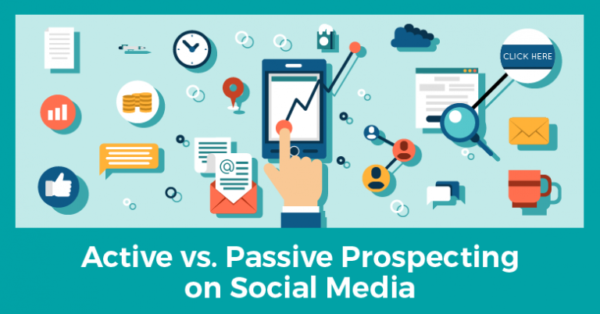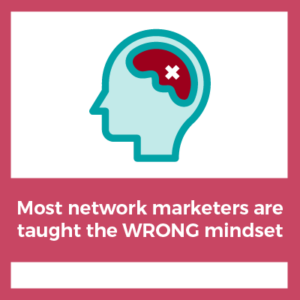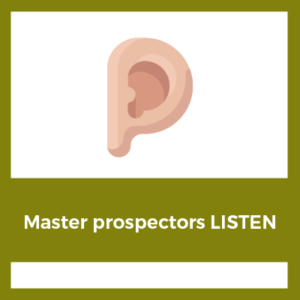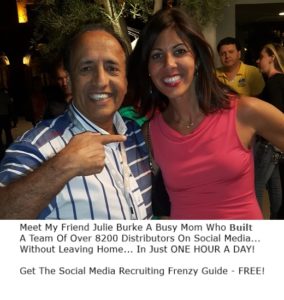(Please enjoy this guest blog post from FERNY CEBALLOS)
It’s no secret that social media recruiting is a hot topic in the network marketing space.
These days it seems like distributors everywhere are chomping at the bit to start building their businesses online, using platforms like Facebook, Instagram, and Twitter to find hot new prospects.
But, despite all the buzz, not everyone is achieving success.
Why is that?
Why do some networkers appear to naturally attract an eager crowd, while others seem to near-instantly repel everyone they reach out to?
Well, luckily the answer is simple, the fix is quick…
And it has everything to do with understanding WHAT you’re actually selling.
Hint: despite what your upline might have told you, you’re NOT selling a product or opportunity!
(…to practically anyone that breathes, no less.)
And because of this widespread misunderstanding of our industry, most distributors (through no fault of their own) are following ineffective, outdated, and often downright-irritating prospecting tactics, both online and off.
The master recruiting “secret” is to flip the script on the traditional “pushy” style of approach.
And instead to invite your prospects to sell themselves.
Believe it or not, it’s easier than it sounds—if you know the invitation process, of course!
Read on and you’ll discover how do to just that.
First and foremost, though, we need to get clear on the following distinction…
Active prospecting versus passive prospecting.
Staring with…
Active prospecting
So what is active prospecting?
Well, it’s when you initiate a conversation with the intention of seeing if the person with whom you’re speaking is a “fit” for your product or service.
Basically, you’re trying to create a business interaction, ultimately leading to a sale or a conversation about joining your busines.
Note that you’re the one initiating this conversation.
An example is what we’re normally taught to do in network marketing through our “cold market.”
For instance, approaching a stranger in a public place, striking up a conversation, and eventually delivering an invite to take a look at your business or your product.
Here’s another common active prospecting scenario…
Prospecting your waiter or waitress (or Uber driver), thinking they might be a great fit for your business.
Again, it’s called “active” prospecting because you’re initiating the conversation.
How NOT to actively prospect…
The main problem with active prospecting is that most network marketers are taught the WRONG mindset.
Thus, they’re approaching a potential prospect with a mindset of selfishness, where every conversation has an agenda behind it, and this ulterior motive creates an aura of desperation and neediness.
Which isn’t fun for anyone!
If we’re being honest, who wants to talk to THAT person, right?
If you’ve ever been on the receiving end before, you know exactly what I mean.
It’s uncomfortable and often makes you feel rude.
What does effective prospecting look like?
In contrast with a typical agenda-driven prospecting conversation, master prospectors cultivate a different mindset and radically different behaviors.
Master prospectors always approach from a mindset of service.
Here’s a great quote by Mike Dillard…
“You must give without want before you can have.”
This is from the book Magnetic Sponsoring, which I highly recommend.
It literally changed my life over 10 years ago when I first got started doing network marketing online, so I suggest getting yourself a copy ASAP from Amazon.com, if you haven’t read it already.
Here’s what you need to always remember…
People aren’t prospects.
People are people.
And people only become a prospect when there’s an actual interest in your business.
How do you know if there’s an interest in your business?
Well, you ASK questions and LISTEN.
Crazy, right? 😉
A master prospecting conversation involves asking questions and listening for a need, want, problem, or desire.
Here’s what that looks like in practice…
At some point, as someone is sharing their story, they’re going to say something that gets your ears “perked up,” because that person expressed something that’s wrong in their life, a problem that they have, or a need, want, or desire they want to fulfill on.
Only once you’ve identified their problem can you help them to achieve a solution.
As master prospector listens for that “in” point during the conversation, and then, and only then, might they reply…
“Hey, John. This {insert problem} seems to be really important to you. If I can introduce you to something which could help you with that, would you be open to hearing about it?”
This is what a master prospector does.
A master prospector invites, based on a specific desired outcome or the solution to a certain problem that somebody has expressed during a conversation.
Again, this approach is coming from a viewpoint of service.
You’re helping—truly helping—that person.
Why some people are good at recruiting and some people SUCK at recruiting!
Effective recruiting comes down to mindset.
That’s 90% of the issues faced by struggling networkers right there.
The problem stems from the fact that most companies, most trainers, and most uplines all condition you in the wrong way, by telling you…
“You just need to get three who get three who get three who get three. You just need to find more people. If things aren’t working in your business, it’s okay! You just need to find more people and bring them to the meetings, etc.”
They’re conditioning you to solve YOUR problems…
“YOU need to find more people (if you want your business to grow).”
Instead, the advice should be to solve your PROSPECT’S problems…
“You need to listen for people with specific problems or desires with whom our business our product can help.”
Does that make sense?
Can you see the difference?
Let’s go over that one more time, because it bears repeating…
“Listen for people with specific problems or desires with whom our business or product can help.”
Now, imagine…
If that was the message given to network marketers and direct sellers, we probably wouldn’t have many of the issues we’re facing, especially in regards to the FTC and the poor reputation this industry is plagued with.
Because it’s a very different way of building a business.
Who you should be looking for…
As opposed to looking for anyone that breathes, what you’re actually looking for are people with specific issues.
In fact, that’s what the field of marketing fundamentally is.
In a board sense, a marketer is out to solve a problem, and to do so, they craft a message illustrating how their product can help solve that specific problem.
For instance, if you’re marketing a local banking institution, then you’re probably trying to find people who might be concerned about stashing cash in their mattress, right?
This problem-solving approach is the best way to do active prospecting.
And like I’ve said, you’ve got to actively listen for people’s specific problems or desires so you can determine how to help them.
Be genuine in that.
If you’re speaking with somebody who does not express a problem or desire in their life, and yet you try to just pitch them anyway, that’s not going to work.
Fortunately, most people have problems!
And hopefully you’re promoting a product that serves the needs of people in a mass market, where a lot of people stand to benefit.
But always keep in mind that your prospects need to express their problem first!
Passive prospecting
Now, let’s discuss “passive prospecting,” which is unique to online social media recruiting.
This strategy is actually best communicated via a story about my good friend and massively successful networker, Julie Burke, which will illustrate the benefits of passive prospecting.
So here’s Julie’s story…
When Julie got started in the network marketing space, it was her first time in network marketing.
She didn’t want to approach her friends and family, or make a list of 100, because she thought that was too limiting.
Instead, she wanted to build her business BIG, and she simply didn’t have enough friends and family, so she went straight to the cold market using Facebook.
She was new to Facebook at the time, but she quickly started making connections with different people.
When she finally felt ready, she put up her first Facebook post.
And she couldn’t even imagine what happened next.
Importantly, this post wasn’t about her company or what business she was involved in.
Instead, it was about a RESULT she had achieved from consuming a product insider her company.
She basically announced…
“Hey, I’m so happy I achieved abc result through using xyz! My life is changed. And it’s amazing. I’m loving it.”
Again, she didn’t mention a product by name.
She didn’t mention that she was part of any business opportunity.
And incredibly, that same day she had 45 messages arrive in her inbox with people asking what she was doing and how they can do it as well!
That first month, she made $2,300 in commissions.
Which is pretty cool, don’tcha think?
Now, if you want to learn more about how Julie built my team of over 8,300 people, hit six-figures in her 13th month, and achieved MULTI-six figures just a few months later…
Click here to download Julie’s Social Medial Recruiting Frenzy Guide absolutely FREE!
So in brief…
Passive prospecting equals people reaching out to you
When you’re using social media to passively prospect effectively, people will ask you about your product or opportunity (instead of you having to tell them about it).
And actually, people won’t so much be asking specifically about your product or opportunity, but instead about how they can achieve a certain result or get a certain benefit for themselves.
They’ll see you as somebody that can show them how to achieve the result they want, based on the posts that they’re seeing.
For example, let’s say you’re helping people lose weight, or look better, or overcome certain ailments, or transform their lifestyle, or achieve financial freedom, then, to promote your business on social media, you’re focused on saying…
“I’m so proud of John. He just was able to achieve x, y, and z. Love you, John! Keep up the great work.”
Well, guess what—when your prospects see this, they’ll go…
“Wow! I too want the results John has!”
That’s the type of post that elicits passive inquiries where people now are reaching out to you.
That’s a whole new prospecting mindset.
It puts you in a position of authority because people are now reaching out to you, because you know something they don’t.
This creates tremendous leverage.
Most network marketers are recruiting in a disempowering way!
Most networkers focus their message on their company or their product.
I hate to break it to you, but that’s exactly what the company wants you to do, because it takes the power away from the distributor and gives it to the company.
In this scenario, the reason why somebody would want to join the company is because of the company, not because of the person that brought them in.
The right way to passively recruit on social media is to focus on the benefit and the impact you’re making in people’s lives, not on any one company, product, or service.
The moment you start introducing your company’s products, or specifically, the company name in any of your social media posts, you’re commoditizing yourself.
Which basically means you’re really no different than the products on the shelves in the stores (like pills or vitamins) that are represented by company labels of multi-million dollar, or billion dollar brands.
In contrast…
You can’t commoditize expertise, a friend, or somebody that’s willing to help.
These aren’t commoditizeable, and they are precisely what makes you unique and attractive to your prospects.
Finally…
People on Facebook don’t want to buy stuff!
No one goes to Facebook to seek out new products to buy, right?
They want to be informed, mostly entertained, and to connect with other people.
Now, when you’re sharing that you’ve helped someone achieve a result, that’s entertaining because your audience is inspired and people will want to connect so they can keep informed about what you’re up to.
Remember, your audience doesn’t know there’s a product involved.
Sure, maybe they have an inkling, but it’s pretty much kept in the background.
The focus is on what you can actually DO for people’s lives, which tends to inspire people on social media and results in these types of passive inquiries.
Bottom line is this…
Be a solution provider.
Be somebody who’s knowledgeable about helping people in specific areas of their life.
Employing active and passive recruiting together for maximum effect
For quickest results, not only should you be doing active prospecting, but you should also heavily focus on sharing inspiring results, which, of course, encourages people to reach out to you passively.
Now, if you want to dive deeper into how passive recruiting is done, see proven examples, and get fill-in-the-blank templates for the types of posts you can use to create curiosity and interest…
Click here to DOWNLOAD Julie’s “Social Medial Recruiting Frenzy” Guide absolutely FREE!
Julie is a master recruiter and she’s tested all kinds of different posts over the past three to four years and pretty much has figured out what type of strategies on Facebook work (and what doesn’t work).
So if you’d like to learn how Julie personally sponsored 270+ reps and grew a team of 8,300 distributors from the comfort of her home in 3 years, using these passive social media recruiting strategies…
DOWNLOAD Julie’s “Social Medial Recruiting Frenzy” Guide absolutely FREE!
Sincerely,
Facebook
Linkedin
Twitter
Email Me
P.P.S. If you found value if this message please like, comment and share.
























